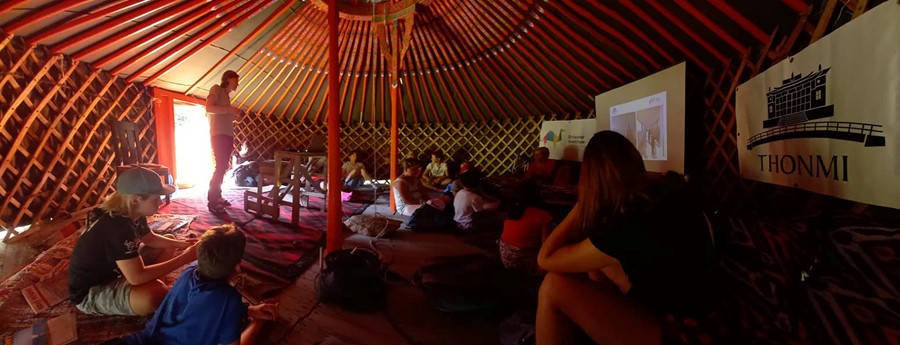
The yurt is a traditional dwelling of Central Asian and Mongolian nomadic herders living on the steppes.
The herders’ need to move to new pastures is matched by their traditional style of living. The circular yurt, consisting of a lightweight wooden folding grid as walls, a roof, a wooden door frame and a covering tarpaulin, can be easily folded and moved. While the original yurts have no floor or windows, modern yurts on permanent sites are set on a wooden floor structure and may have a glazed skylight. In winter, the yurt is heated by a fire made from dried cattle dung, which is also cooked on – more recently on an iron stove. Strips of sheep’s wool felt are used as frost protection, and in summer it is ventilated by lifting the edge of the cover. The yurt can be heated quickly, but in winter frosts it must be constantly covered.
The traditional layout for multiple yurts is a circle that forms a small village. The diameter of the yurt varies from 3 to 20 metres. The yurts used in the windswept Mongolian steppe are lower; yurts in Kyrgyzstan, Kazakhstan or Turkmenistan have a higher domed roof.
The different parts of the yurt have their own symbolism. The most important is the north side – the place for the altar – and the fireplace in the centre. The left half is where the men sit and the men’s utensils are stored, while the right half belongs to the women and the kitchen. The decoration of the yurts, especially the doors, the internal wooden elements or the edges of the covering sheet, also play an important role. The decoration varies from one area to another. Doors, especially in Mongolian areas, tend to be richly decorated according to tribal traditions.
The crown (roof) is the most important part of the yurt in Central Asian countries and was inherited from father to son in the past. Some Central Asian states use a stylized yurt crown on their state symbols (the state emblem of Kazakhstan, the state flag of Kyrgyzstan).
Nowadays, yurts in Central Asian regions are used, for example, as cafes or museums. Yurts are also gaining popularity in Europe and America. The largest yurt in the world is in Turkmenistan and is made of concrete, granite, aluminium and glass. It is 35 m high, measures 70 m in diameter and can accommodate 3 floors including a hall for 3000 spectators.
